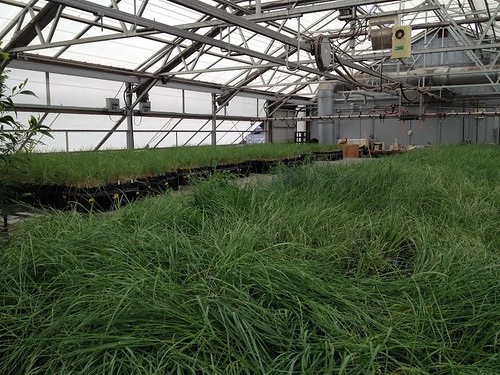
Wildfires in sagebrush and other range ecosystems are increasing in frequency and severity, often in relation to drought conditions and intrusive species like cheatgrass, a non-native, highly flammable invasive species that establishes itself as a monoculture and crowds out native grasses and forbs.
“What’s preferable to a monoculture is a diverse plant community that includes native grasses, forbs and shrubs,” said Francis Kilkenny, leader for the Great Basin Native Plant Project, a joint effort of the U.S. Forest Service and the Department of Interior’s Bureau of Land Management, or BLM.
Restoring a disturbed ecosystem back to health has positive practical consequences as well.
A district manager with BLM can easily obtain and plant several seed types to optimize a restoration project. Preliminary research helps the manager identify which seed varieties have the best chance of succeeding in a given region of the country at a particular elevation, at particular time of the year and under current climate conditions.
But, those findings do not come easily. It takes decades to develop successful new seed varieties for grasses. Research on forbs (broad-leaved non-woody plants) and shrubs still has a long way to go. What they’ve learned so far is that in addition to the right climate conditions, timing of seed planting makes a big difference.
Method of planting also matters. Tamping seeds into the soil is better than blowing them from a plane, for instance. Keeping livestock off newly seeded rangeland for at least three years really improves the likelihood of a successful restoration effort. And, long-term monitoring is critical to our understanding of what seed mixes and restoration techniques yield long-term restoration success.
Delivering this kind of knowledge to land managers is the other side of the coin. Collecting existing research results into a single digital library, holding webinars, producing an annual report of new findings, establishing a National Seed Strategy, and trading information with groups like the Great Basin Fire Exchange have all advanced national restoration efforts.
“We’ve learned an awful lot about what doesn’t work, but our knowledge has advanced considerably since the Dust Bowl,” Kilkenny said.
NOTE: A new report by the U.S. Forest Service, Effects of Drought on Forests and Rangelands in the United States: A Comprehensive Science Synthesis, provides a national assessment by 77 scientists of peer-reviewed research on the impacts of drought on U.S. forests and rangelands. This report will help the Forest Service better manage grasslands and forests impacted by drought, wildfire, invasive plants and other challenges made worse by climate change.
“Our forests and rangelands are national treasures, and because they are threatened, we are threatened,” said Agriculture Secretary Tom Vilsack. “This report confirms what we are seeing, that every region of the country is impacted by the direct and indirect effects of drought conditions and volatile weather patterns. Sixty million Americans rely on drinking water that originates on our 193 million acres of national forest and grasslands. They support 200,000 jobs and contribute over $13 billion to local economies every year.”
The report establishes a comprehensive baseline of available data that land managers can use to test how well their efforts to improve drought resilience and adaptation practices are working nationwide.




